
Back in 1944, Hollywood’s “Hays Code” made it perfectly clear. If you wanted to make a movie, your film had better not show any of the following: “brutality and possible gruesomeness, technique of committing murder by whatever method, sympathy for criminals, …“ The list of no-nos went on and on.
So how, then, did Paramount Pictures manage in 1944 to make a movie out of James M. Cain’s Double Indemnity, a film in which insurance salesman Fred MacMurray and housewife Barbara Stanwyck plot and execute the murder of her husband—and make it look like an accident so as to cash in on hubby’s insurance policy’s “double indemnity” clause, one which guarantees double the payout in case of accidental death?
Mike Bencivenga’s World Premiere play Billy & Ray not only explains how co-screenwriters Billy Wilder and Raymond Chandler found ingenious ways to hoodwink Hays Code czar Joseph Breen into letting them include all of the abovementioned taboos in their movie, under Garry Marshall’s pitch-perfect direction, it does so in the most entertaining of ways.
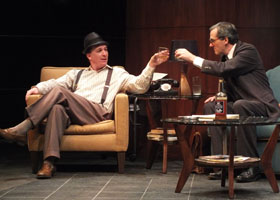 “It’s sordid, violent, disgusting. The studio won’t touch it, but if anyone can get this past those production code censors, you and Charlie can,” producer Joseph Sistrom (Anthony Starke) tells Billy (Kevin Blake) in the play’s opening sequence, which is why despite the apparent impossibility of filming Cain’s novella, the studio exec went ahead anyway and bought the rights for a not measly $15,000 (an impressive $325,000 in today’s terms).
“It’s sordid, violent, disgusting. The studio won’t touch it, but if anyone can get this past those production code censors, you and Charlie can,” producer Joseph Sistrom (Anthony Starke) tells Billy (Kevin Blake) in the play’s opening sequence, which is why despite the apparent impossibility of filming Cain’s novella, the studio exec went ahead anyway and bought the rights for a not measly $15,000 (an impressive $325,000 in today’s terms).
Unfortunately for Sistrom, Billy’s longtime collaborator Charles “Charlie” Brackett has recently put an end to their screenwriting partnership, and though Billy is convinced he’ll be back sooner or later, later is unfortunately too late to get Double Indemnity turned into a script in time.
So Joe makes a suggestion. How about getting The Big Sleep author, novelist Raymond Chandler (Shaun O’Hagen), to co-write with Billy?
Despite never having heard of said Raymond Chandler, Billy agrees to give the partnership a try, a quick perusal of Chandler’s prose having impressed the director-screenwriter with lines like, “Nothing is emptier than an empty swimming pool.” “Who writes like that?” exclaims Billy in a combination of disbelief and awe.
Though “Ray” Chandler is as clueless about Hollywood as Billy Wilder is about Chandler (“Who’s Goldwyn?” Ray asks in complete innocence), the novelist agrees to write the screenplay (and promises to do so in a mere ten days), provided the studio lets him do it all by himself at home. All that’s needed is to get a hold of a script so he can see what one looks like.
Ten days later, Ray is back with a screenplay Joe and Billy dub “shit,” so full is it of things which have no place in a script. Thus, having wasted ten days doing it Ray’s way, Billy and Ray are now going to do it the right way—together, and if collaborating with another writer seems unnatural to Ray, Billy assures him, “It’s like riding a unicycle. It’s completely unnatural, but you get used to it.”
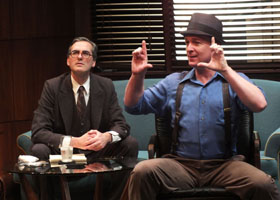 Billy & Ray recalls 2004’s Moonlight And Magnolias, in which playwright Ron Hutchinson details the week during which David O. Selznick, Victor Fleming, and Ben Hecht wrote the screenplay for Gone With The Wind. Bencivenga takes a similar conceit and adds to it elements of Neil Simon’s classic The Odd Couple to hilarious effect.
Billy & Ray recalls 2004’s Moonlight And Magnolias, in which playwright Ron Hutchinson details the week during which David O. Selznick, Victor Fleming, and Ben Hecht wrote the screenplay for Gone With The Wind. Bencivenga takes a similar conceit and adds to it elements of Neil Simon’s classic The Odd Couple to hilarious effect.
On the one hand, there’s Billy Wilder, whose secretary Helen Hernandez (Ali Spuck) seems to spend as much time mixing cocktails for her boss as she does doing office duties, a man whose frequent dalliances make him the equal of any Hollywood “player.” On the other hand, there’s Ray Chandler, an old-school gent so straight-laced, he doesn’t play cards, doesn’t follow sports, and doesn’t even drink—or so he says.
Besides providing considerable “Odd Couple” laughter throughout, Billy & Ray fascinates with its many revelations about just how Double Indemnity made it from page to screen in an era of de facto film censorship dubbed “adhering to The Code.”
We learn, for example, that one of the first things Billy and Ray did was to change the last names of the murderous lovers, Walter’s because there was someone with the insurance agent’s original name living in nearby Encino, and Phyllis’s from Nerdlinger to Dietrichson because, as Billy would surely have put it, who’d want to schtup a woman named Nerdlinger?
But this was nothing compared to the hard stuff, finding way after way to outsmart the Code, since everything in the movie—adultery, cold-blooded murder, even double indemnity—was taboo.
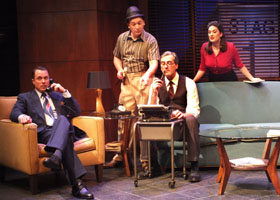 Over the course of its roller-coaster-ride two acts, Billy & Ray allows us to be flies on the walls of some very special walls indeed. We learn about one of Wilder and Chandler’s greatest strokes of genius—not showing the murder itself but rather Barbara Stanwyck’s face as she witnesses it, and another, having Walter and Phyllis plot the murder in Jerry’s Market—a murder planned not in the darkness of a smoky bar but in the bright light of day.
Over the course of its roller-coaster-ride two acts, Billy & Ray allows us to be flies on the walls of some very special walls indeed. We learn about one of Wilder and Chandler’s greatest strokes of genius—not showing the murder itself but rather Barbara Stanwyck’s face as she witnesses it, and another, having Walter and Phyllis plot the murder in Jerry’s Market—a murder planned not in the darkness of a smoky bar but in the bright light of day.
Obviously, the more you know about 1940s Hollywood (and Double Indemnity in particular), the more you’ll enjoy Billy & Ray. At the same time, Bencivenga’s comedy is so downright entertaining that even those with considerably less Hollywood savvy are likely to have a rollicking good time.
Billy & Ray is filled with Neil Simonesque one-liners (“Somebody bring me a blueprint of George Raft’s brain because I want to build an idiot”), Bencivenga’s extensive research suggesting that Billy Wilder may well have said many if not all of the laugh-getting lines written for him here.
Marshall directs—at the ripe young age of seventy-eight—with his trademark precision and panache, aided by longtime protégé, assistant director Joseph Leo Bwarie. Among Marshall tricks, there’s a hilarious bathroom sequence that exhibits the Hollywood legend’s mastery of comic timing, blocking that appears entirely organic throughout, and a clever recurring window-and-blinds bit that’s an inspired bit of genius.
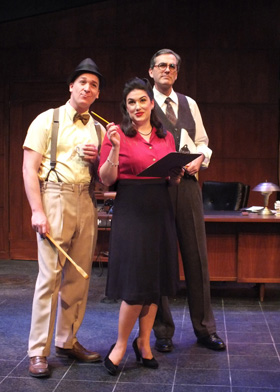 Performances are all-around terrific, from Starke’s spot-on work as harried Hollywood exec Sistrom, for whom if Double Indemnity weren’t already headache enough, there was also the matter of attempting to film a script with the godawful title “Hitler’s Children,” to Spuck’s pizzazzy channeling of Rosalind Russell and Eve Arden in her snappy performance as real-life secretary Helen.
Performances are all-around terrific, from Starke’s spot-on work as harried Hollywood exec Sistrom, for whom if Double Indemnity weren’t already headache enough, there was also the matter of attempting to film a script with the godawful title “Hitler’s Children,” to Spuck’s pizzazzy channeling of Rosalind Russell and Eve Arden in her snappy performance as real-life secretary Helen.
Then there’s O’Hagan, doing standout work as always as “Felix” to Blake’s “Oscar,” a smartly understated Ray that allows his costar to play Billy with a razzmatazz and dazzle that would likely have suited Wilder to a T. From the twinkle in his eye when he’s about to zap Ray with yet another zinger to the way he commands a stage with Austrian ebullience and élan, Blake’s Billy is bound to be one of the most talked-about performances of the year.
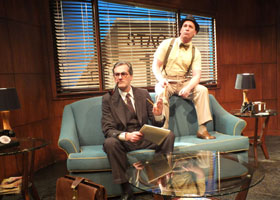 As for Billy & Ray’s look and sound, it’s clear that no expense has been spared to make this one of the classiest productions around town, beginning with Keith Mitchell’s masterfully detailed set, one which surrounds Billy’s center-stage office with Sistrom’s on the left and Helen’s on the right, the better to facilitate lickety-split scene changes. Heather Ho once again deserves major kudos for her period-perfect props—phones, typewriters, and various ‘40s Hollywood paraphernalia. Jeremy Pivnick’s lighting is equally expert, signaling time of day and upping dramatic moments along with other tricks of the lighting designer’s trade. David Beaudry’s sound design is as good as it gets as are costume designer Terri A. Lewis’ terrific 1944 fashions.
As for Billy & Ray’s look and sound, it’s clear that no expense has been spared to make this one of the classiest productions around town, beginning with Keith Mitchell’s masterfully detailed set, one which surrounds Billy’s center-stage office with Sistrom’s on the left and Helen’s on the right, the better to facilitate lickety-split scene changes. Heather Ho once again deserves major kudos for her period-perfect props—phones, typewriters, and various ‘40s Hollywood paraphernalia. Jeremy Pivnick’s lighting is equally expert, signaling time of day and upping dramatic moments along with other tricks of the lighting designer’s trade. David Beaudry’s sound design is as good as it gets as are costume designer Terri A. Lewis’ terrific 1944 fashions.
Dale Alan Cooke is stage manager, Heather Hall associate producer, and Amy Lieberman, CSA, casting director.
Only in Billy & Ray’s anti-climactic epilog does playwright Bencivenga make a misstep, choosing to fill us in with the kind of “and this is what happened to” factoids that would work as part of a movie’s end-title sequence but seem tacked on to an ending (courtesy of sound designer Beaudry) that if left alone would conclude Billy & Ray with a gasp-inducing wallop.
Still, that’s about the only nit I can find to pick in just about as splendid a season ender as any theater could wish for. Proving that Garry Marshall (and his Falcon Theatre) are still at the top of their game, Billy & Ray is manna from film buffs’ heaven.
Falcon Theatre, 4252 Riverside Drive, Burbank.
www.falcontheatre.com
–Steven Stanley
April 5, 2013
Photos: Chelsea Sutton


 Since 2007, Steven Stanley's StageSceneLA.com has spotlighted the best in Southern California theater via reviews, interviews, and its annual StageSceneLA Scenies.
Since 2007, Steven Stanley's StageSceneLA.com has spotlighted the best in Southern California theater via reviews, interviews, and its annual StageSceneLA Scenies.







 COPYRIGHT 2024 STEVEN STANLEY :: DESIGN BY
COPYRIGHT 2024 STEVEN STANLEY :: DESIGN BY